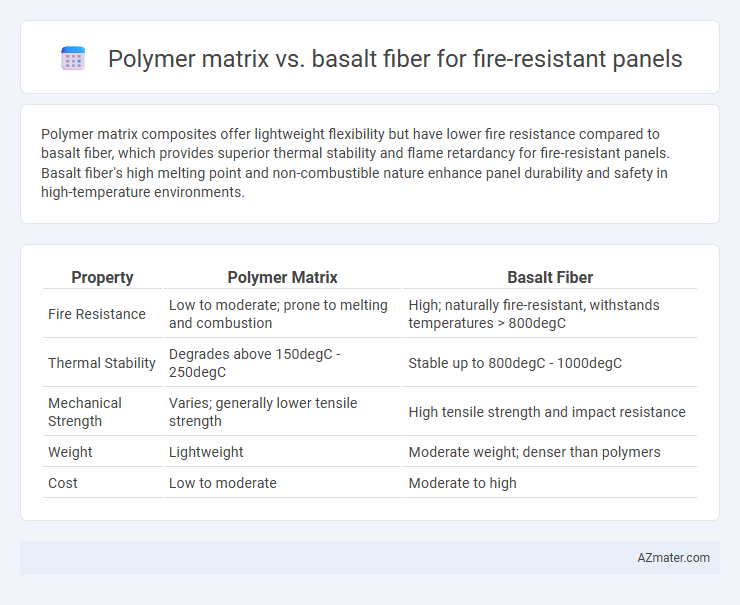Polymer matrix composites offer lightweight flexibility but have lower fire resistance compared to basalt fiber, which provides superior thermal stability and flame retardancy for fire-resistant panels. Basalt fiber's high melting point and non-combustible nature enhance panel durability and safety in high-temperature environments.
Table of Comparison
| Property | Polymer Matrix | Basalt Fiber |
|---|---|---|
| Fire Resistance | Low to moderate; prone to melting and combustion | High; naturally fire-resistant, withstands temperatures > 800degC |
| Thermal Stability | Degrades above 150degC - 250degC | Stable up to 800degC - 1000degC |
| Mechanical Strength | Varies; generally lower tensile strength | High tensile strength and impact resistance |
| Weight | Lightweight | Moderate weight; denser than polymers |
| Cost | Low to moderate | Moderate to high |
Introduction to Fire-Resistant Panels
Fire-resistant panels utilize advanced materials such as polymer matrices and basalt fibers to enhance thermal stability and structural integrity under high temperatures. Polymer matrices offer lightweight flexibility and ease of processing, while basalt fibers provide superior fire resistance, thermal insulation, and mechanical strength due to their natural composition of volcanic rock. Combining these materials can optimize panel performance in fire safety applications, ensuring durability and compliance with stringent fire protection standards.
Overview of Polymer Matrix Materials
Polymer matrix materials used in fire-resistant panels typically include thermosetting resins such as epoxy, phenolic, and polyester, each offering distinct thermal stability and smoke emission profiles. These polymers provide excellent adhesion to reinforcement fibers and can be engineered to enhance fire retardant properties through additives and modifiers. Effective polymer matrices balance mechanical strength, heat resistance, and durability, making them crucial components in composite fire-resistant panels combined with basalt fiber reinforcements.
Understanding Basalt Fiber Composition
Basalt fiber, derived from volcanic basalt rock, consists primarily of silicon dioxide (SiO2), aluminum oxide (Al2O3), and calcium oxide (CaO), providing excellent thermal stability and fire resistance compared to traditional polymer matrices. Its natural mineral composition gives basalt fiber superior resistance to high temperatures up to 600degC, reducing combustion risks and structural degradation in fire-resistant panels. Incorporating basalt fiber in fire-resistant panels enhances mechanical strength and fire performance over polymer matrices, which often degrade or release toxic fumes under intense heat.
Thermal Resistance: Polymer Matrix vs Basalt Fiber
Basalt fiber offers superior thermal resistance compared to typical polymer matrices, withstanding temperatures up to 860degC without significant degradation, making it ideal for fire-resistant panels. Polymer matrices generally have lower thermal stability, often softening or degrading at temperatures above 200degC to 300degC, which limits their effectiveness in high-temperature fire scenarios. Combining basalt fibers with fire-resistant polymer matrices enhances the overall thermal resistance of composite panels used in fire protection applications.
Mechanical Performance Under Fire Exposure
Polymer matrix composites exhibit significant mechanical degradation when exposed to fire, resulting in reduced structural integrity and load-bearing capacity. Basalt fiber reinforcements enhance the fire resistance of panels by maintaining higher tensile strength and modulus at elevated temperatures compared to traditional polymer matrices. The superior thermal stability and low thermal conductivity of basalt fibers contribute to sustained mechanical performance under fire exposure, making them a preferred choice for fire-resistant panel applications.
Durability and Longevity in Fire Scenarios
Polymer matrix composites reinforced with basalt fiber exhibit superior durability and longevity in fire-resistant panels due to basalt's high thermal stability and resistance to thermal degradation compared to traditional polymer matrices. Basalt fibers maintain structural integrity at temperatures exceeding 800degC, significantly enhancing panel lifespan under fire exposure. This combination reduces degradation rates and preserves mechanical properties longer than panels made solely with polymer matrices or conventional fibers.
Environmental Impact Assessment
Polymer matrix composites and basalt fiber differ significantly in their environmental impact for fire-resistant panels, with basalt fiber offering superior eco-friendly properties due to its natural volcanic rock origin and recyclability. Life Cycle Assessment (LCA) studies reveal basalt fiber production generates lower carbon emissions and energy consumption compared to polymer matrices, which rely on petrochemical sources and emit volatile organic compounds (VOCs) during manufacturing and disposal. The non-toxic, non-corrosive nature of basalt fiber panels enhances end-of-life treatment options, minimizing ecological harm compared to the challenging degradation and potential release of hazardous substances from polymer-based panels.
Cost Analysis and Economic Feasibility
Polymer matrix composites generally offer lower initial costs and easier manufacturing processes compared to basalt fiber composites, making them economically feasible for large-scale fire-resistant panel production. Basalt fiber panels, while more expensive upfront due to raw material and processing costs, provide enhanced fire resistance and durability that can reduce long-term maintenance and replacement expenses. Cost analysis must balance the initial investment against lifecycle savings, with polymer matrices favored for budget-constrained projects and basalt fibers preferred for applications requiring superior fire protection and extended service life.
Application Suitability: Best Use Cases
Polymer matrix composites excel in lightweight fire-resistant panels ideal for aerospace and automotive applications requiring corrosion resistance and electrical insulation. Basalt fiber panels offer superior thermal stability and mechanical strength, making them well-suited for construction, industrial, and transportation sectors exposed to high temperatures and aggressive environments. Choosing between these materials depends on balancing weight, fire performance, and structural demands tailored to specific application requirements.
Future Trends in Fire-Resistant Panel Materials
Polymer matrix composites reinforced with basalt fiber exhibit superior fire resistance and thermal stability compared to traditional materials, making them a focal point in developing next-generation fire-resistant panels. Future trends emphasize enhancing the polymer matrix with nano-additives and hybridizing basalt fibers with other fire-retardant materials to improve mechanical strength and flame-retardant properties. Advances in sustainable and eco-friendly polymers combined with basalt fiber aim to balance performance, cost, and environmental impact in fire-resistant panel applications.

Infographic: Polymer matrix vs Basalt fiber for Fire-resistant panel
 azmater.com
azmater.com